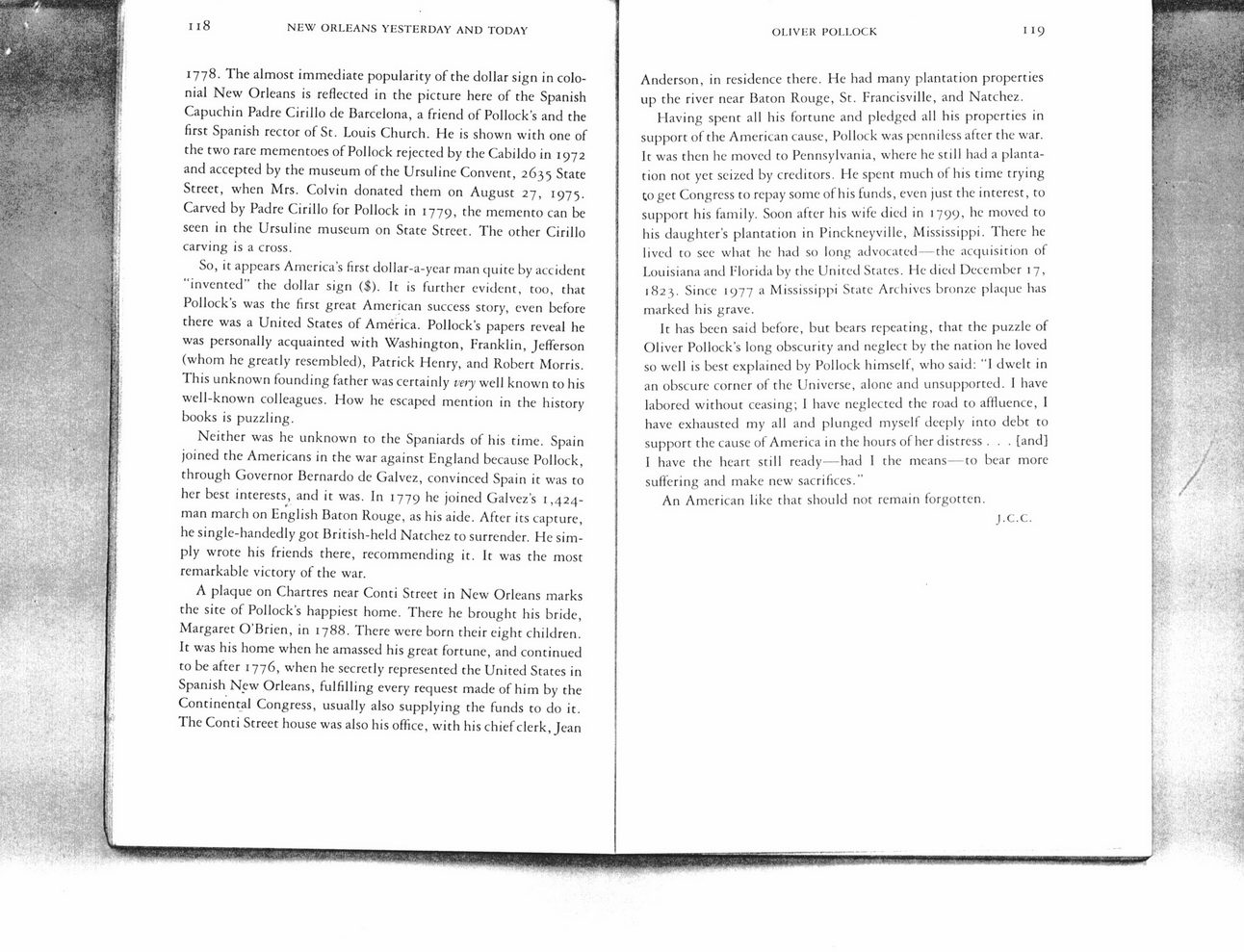This text was obtained via automated optical character recognition.
It has not been edited and may therefore contain several errors.
118 NEW ORLEANS YESTERDAY AND TODAY 1778. The almost immediate popularity of the dollar sign in colonial New Orleans is reflected in the picture here of the Spanish Capuchin Padre Cirillo de Barcelona, a friend of Pollock's and the first Spanish rector of St. Louis Church. He is shown with one of the two rare mementoes of Pollock rejected by the Cabildo in 1972 and accepted by the museum of the Ursuline Convent, 2635 State Street, when Mrs. Colvin donated them on August 27, 1975. Carved by Padre Cirillo for Pollock in 1779, the memento can be seen in the Ursuline museum on State Street. The other Cirillo carving is a cross. So, it appears America?s first dollar-a-year man quite by accident "invented? the dollar sign ($). It is further evident, too, that Pollock?s was the first great American success story, even before there was a United States of America. Pollock's papers reveal he was personally acquainted with Washington, Franklin, Jefferson (whom he greatly resembled), Patrick Henry, and Robert Morris. This unknown founding father was certainly very well known to his well-known colleagues. How he escaped mention in the history books is puzzling. Neither was he unknown to the Spaniards of his time. Spain joined the Americans in the war against England because Pollock, through Governor Bernardo de Galvez, convinced Spain it was to her best interests, and it was. In 1779 he joined Galvez's 1,424-man march on English Baton Rouge, as his aide. After its capture, he single-handedly got British-held Natchez to surrender. He simply wrote his friends there, recommending it. It was the most remarkable victory of the war. A plaque on Chartres near Conti Street in New Orleans marks the site of Pollock's happiest home. There he brought his bride, Margaret O'Brien, in 1788. There were born their eight children. It was his home when he amassed his great fortune, and continued to be after 1776, when he secretly represented the United States in Spanish New Orleans, fulfilling every request made of him by the Continental Congress, usually also supplying the funds to do it. The Conti Street house was also his office, with his chief clerk, Jean OLIVER POLLOCK 119 Anderson, in residence there. He had many plantation properties up the river near Baton Rouge, St. Francisville, and Natchez. Having spent all his fortune and pledged all his properties in support of the American cause, Pollock was penniless after the war. It was then he moved to Pennsylvania, where he still had a plantation not yet seized by creditors. He spent much of his time trying to get Congress to repay some of his funds, even just the interest, to support his family. Soon after his wife died in 1799, he moved to his daughter's plantation in Pinckneyville, Mississippi. There he lived to see what he had so long advocated?the acquisition of Louisiana and Florida by the United States. He died December 17, 1823. Since 1977 a Mississippi State Archives bronze plaque has marked his grave. It has been said before, but bears repeating, that the puzzle of Oliver Pollock's long obscurity and neglect by the nation he loved so well is best explained by Pollock himself, who said: "1 dwelt in an obscure corner of the Universe, alone and unsupported. I have labored without ceasing; I have neglected the road to affluence, I have exhausted my all and plunged myself deeply into debt to support the cause of America in the hours of her distress . . . [and] I have the heart still ready?had 1 the means?to bear more suffering and make new sacrifices." An American like that should not remain forgotten. J.C.C.

Pollock Family 007